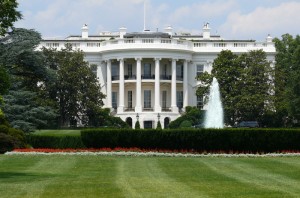Rules Are for Schmucks: More Faith-Based Initiative Loopholes

There are a couple of different ways to look at the “faith-based initiative” launched by President George W. Bush and expanded by President Obama. One is that it’s simply a way to make it easier for religious groups to compete for federal grants and contracts. More competition is a good thing, no? Some religious groups undoubtedly can do an efficient job of delivering social services.
The other way to view it is as a backdoor scheme for funneling taxpayers’ money to prop up religion, using clever legal tricks to circumvent the separation of church and state.
New regulations proposed by the Department of Labor in August are further evidence for the “backdoor money grab” theory.
In classic “wolf in sheep’s clothing” style, the proposed regulations are seemingly designed to restrict some of the dangers of handing federal funds over to religious groups. Their main point is that a federal grant or contract recipient, e.g., the sponsor of a job training or child care program, must notify its customers that it doesn’t discriminate based on religious grounds and that it can’t force those customers to attend religious services as a condition of receiving assistance. The notice must also say that if the customers object to the religious character of the service provider, they are entitled to a referral elsewhere. Certainly, it’s a bad idea to use tax money to support an outfit that is so in-your-face religious as to violate anything it says in the required notice. As candidate Obama said in 2007, “If you get a federal grant, you can’t use that grant money to proselytize to the people you help and you can’t discriminate against them—or against the people you hire—on the basis of their religion.”
Obama has already officially reneged on the hiring part of his promise. These regulations pull the rug further out from under the proselytizing part. As with most things, the devil (or in this case, the deity) is in the details.
Here’s the first problem: the regulation thoughtfully provides the exact text of the notice the service provider (e.g., the childcare program) must give its customers. It’s well-written. But then the regulation goes on to say how the notice must be provided, explicitly including “through electronic means.” In other words, it’s perfectly okay to bury the notice seven layers deep on the organization’s website, perhaps under some enticing title like “Government Notice.”
Then there’s the noble idea, as stated in the notice that no one is going to see, that “if a beneficiary objects to the religious character of the organization, the organization will undertake reasonable efforts to identify and refer the beneficiary to an alternative provider to which the prospective beneficiary has no objection.” And what happens if those “reasonable efforts” fail to identify an alternative provider? Nothing. The customer is now in the realm of “Too damn bad,” and will have to put up with however overbearing the religious service provider wants to be.
The proposed regulation freezes in place some of the more pernicious aspects of the current rules. For example, government-paid services can be offered in places where the walls are plastered with “religious art, icons, scriptures, or other religious symbols.” Much worse than that, though, is the artificial distinction drawn between “direct” and “indirect” government payments.
A “direct” payment is the traditional government grant or contract, in which the government pays the service provider to help its customers. An “indirect” payment is more like a voucher arrangement, in which the customer can pick and choose which service provider will be paid by the government for providing services to that customer. Either way, it’s still money, it’s still green, and it still comes from taxpayers like me.
All the high-sounding rules against using federal money to proselytize, to discriminate for or against members of any religion, or to condition providing services on religious observance apply only to “direct” federal payments. None of them apply to “indirect” payments. “Indirect” payments of taxpayer money can freely be made to the most egregious religious soul-capturing schemes you can imagine.
Religious schools have been lobbying for decades for a voucher system in which tax money is funneled to them through parents who disdain the public schools. In nearly all places, this idea has been rejected, and at least one court recently ruled it unconstitutional. Whether or not it’s constitutional, it’s a terrible idea. A terrible idea now formally enshrined in Obama administration regulations for federal grants and contracts, including those for “Childcare services and … job training,” which sounds a whole lot like a “school.”
Here’s a simple church fundraising plan: (1) start a “childcare service” to run concurrently with your regular Sunday programming; (2) teach members of your congregation how to get federal vouchers for it; (3) brainwash the kids who participate to your heart’s content, with the bills paid by Uncle Sam; and (4) use some of that money you make to send nice thank-you notes to George W. Bush and Barack Obama.
All the legal jargon of federal regulations can get terribly confusing. So let me put it in simple terms. My money should not be used to promote the message that I deserve to be tortured in hell, forever. Period. If any complicated mish-mash of a regulation ends up with my money being used that way, then it’s a bad regulation. If churches want to mix religious messaging in with any community services they provide, no problem—have at it. But not with my money.
